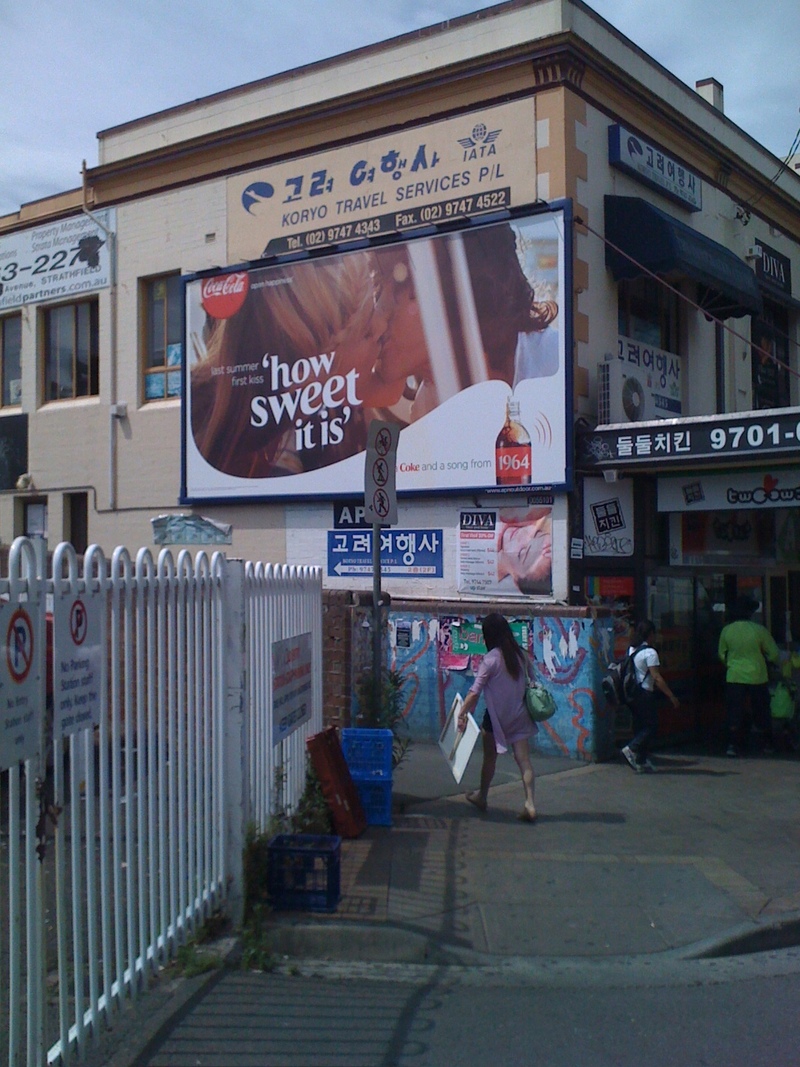 |
| In an alternative universe I might be living in Strathfield, the gateway to western Sydney and home to a large Korean community (Australia, 2012) |
Monday, November 23, 2009
altUniverse Me, Living in Strathfield, Shopping and Eating in Glebe
Why is it that all the good Australian food blogs are written by Asians? To be more precise, why is it that most of the food bloggers in Australia are Malays, or people from the Malay world? By the Malay world I'm referring to Malaysians, Singaporeans, Indonesians, Filipinos, etc, many of whom live, study or work in Australia these days. I don't know whether or not Malaysians invented food blogging but it is definitely a popular pastime for these people, and something they excel at. Just as everyone under the age of 50 in Reykjavik Iceland wants to be in a rock band, every young man or woman in Kuala Lumpur wants to be a food blogger... that is my observation at least! When I lived in Tokyo I was once bluntly informed by one of my housemates, an overweight Japanese gent named Matsumoto-san: "I liked traveling in Australia, but Anglo-Saxons don't understand food." I took that as a slur at the time but I can see where he was coming now -- Anglo-Saxons do indeed suck gastronomically. I think it boils down to our tepid tastes, and to our straitjacketed imagination. What constitutes Anglo-Saxon cuisine, anyway: meat and three veg, the veg boiled beyond blandness? Baked beans if you are English, Vegemite on toast if you are Australian? Hot dogs and hamburgers in North America, sausages on a braai in South Africa? Times may be changing, countries like Australia are supposed to be so cosmopolitan these days, you can even scoff sashimi in a shotglass, or eat wagyu beef on a burger! But I wonder: is this coming of age in a culinary sense, or is it just showing off how wealthy you've become? It's insulting for the sashimi to be served up in a glass, not only to the Japanese whose culture you have ransacked to spice up your workaday reality, but to the fish who donated its flesh and its life to help sustain yours! Show some respect, for God's sake. When I survey the dining scene in a city such as Sydney it seems to be more than a little nouveau riche to me, suggesting that people here have confused money with culture. Good cooking comes from the heart, not from the wallet, and I doubt that Aussies (along with Americans and Kiwis and South Africans and all the rest) will ever be as fanatical about their food as the Asians are about theirs. Young Australians would rather be football players than foodies, or food bloggers. Fair enough -- I will keep to the Asian blogosphere as I research places to go for my impending visit Downunder next month, and there are plenty of sites out there to be read. For example, on the topic of my home for a couple of months at the start of the year 2000, the Asian-Australian eat like a cow posse say: "It's hard to decide what to eat in Glebe - the area along Glebe Point road is full of delicious eateries. In fact, it's somehow like Paddington - but for hippies. This road strip is a melting pot of many cultures and races. One can see a seemingly endless myriad of people types - dreadlocked hippie girls, leather fetishists, even Asians in Louboutins. It's really an oasis in suburbia, lined with charmingly un-renovated old townhouses and fabulously dinghy second-hand shops..."
I haven't been to Australia for a long time now (2.75 years, as of the end of the month), but when I am in Sydney, my way invariably leads to Glebe. Recently I have started thinking: had I not left Australia to live in Japan in 2000, what would have become of me? I probably would have tended to the west (not Western Australia, but western Sydney -- that's where I was working, and that's where the cheaper real estate is to be found.) In my Aussie altUniverse, Glebe Point Rd would probably be as far east as I would stray, as I never really liked the wankers in Bondi. I'd be living in a share house somewhere in the inner west, fighting over the bills, and for kicks I'd drink coffee at Cafe Otto or Clipper Cafe or Badde Manors, or dunk donuts at Dunkins (is that still open?), or trawl for vintage clothes and New Age trinkets at the Saturday markets. My center of gravity would probably be Strathfield Railway Station, gateway to western Sydney as well as to the Chinese/Korean communities of the north-west. In realUniverse my uncle Bill died in the year 2000 somewhere near Oxford Street, and the subsequent chain of events carried me off to Tokyo, where I still reside. I think I like the real universe better than the alternative one, folks know how to cook here and Michelin stars abound. I am pretty settled here, I have my own apartment, no need to share any longer... but sometimes in my dreams the timelines converge, and I find myself back in the altUniverse. Heading off to work at some job I don't like, or waiting for a train which never comes. I wake up, almost with a fright... and realize it was just a dream. But you never know... someday the timelines really will skip, and I could wake up to find myself living in Australia, and Tokyo will be just a dream? Could that ever happen.. well, yes, it could. Stranger things have happened at sea.
Sunday, September 13, 2009
Arco Iris (Peruvian Restaurant in Gotanda)
Of all the diasporas in the world, one of the least well known is the diaspora of Japanese people to South America. As Latin America Links has recorded: "In 1899, the Japanese government was concerned with over population and began a campaign to send Japanese to different parts of the world... 790 Japanese arrived in 1899 (in Peru) to work the sugar and cotton plantations. A significant number of them were from Okinawa..." Peru was not the only New World destination for these poor Japanese settlers: many of them ended up in the agricultural sectors of Brazil and Paraguay among other countries, all of whom were desperately short of (hu)manpower. Japanese DNA entered the racial melting pot of Latin America, but was not totally dissolved; the result is that even today distinctly Japanese communities can be found all over the continent. As the Japanese tourist Kimulog wrote on a 2006 trip to Brazil: "It was Sunday when I came to Sao Paulo first. On Sunday Sao Paulo, many stalls (Yatai in Japanese) are ranging in parks and plazas. One of them, held at Liberdage, was just like Japanese Ennichi. I could find many Japanese meals such as Yakisoba-Oobanyaki-Takoyaki-... ,and many Japanese immigrants working in stalls who can speak both Portuguese and Japanese..."
Diasporas have a habit of returning home, and in recent decades hundreds of thousands of Latin Japanese have been applying for Japanese ancestry visas, and settling in the homeland. Go to any foreigner-friendly psychiatrist's clinic or travel agency, and you will find Spanish language newspapers and magazines. I have seen census figures which show that Brazilians comprise the fourth largest ethnic group in Japan (after Koreans, Chinese and of course the native Japanese!) Those Brazilians are Nisei (second generation descendants of Japanese settlers in North and South America and other parts of the world). Peruvians are also having an impact in Japan: there is a band of Peruvian musicians who regularly make the rounds of major festivals in such places as Iriya (site of the midsummer Morning Glory festival). There is a girl who works for my boss's English school named T. who comes from Peru and looks Peruvian, although her visa says she is ethnic Japanese. My boss calls her a Nisei Japanese although she is probably not second generation at all, but third. Anyway, she wanted to introduce us to the delights of Peruvian food, which is how this adventure began.
Since the loss of my principle Tokyo food sponsor Sasaki-san due to family illness, I have been confined to eating konbini cuisine, or dining in the occasional famiri resutoran, or if I have been really desperate, cooking for myself. Now I must state here that eating convenience store meals in Japan is not the full culinary disaster that it sounds: Japanese convenience store meals are no doubt the best in the world, as my Bankstown food critic Oscar told me on a subway ride home recently (Toei Shinjuku Line, Shinjuku to Bakuroyokoyama.) Oscar said he had visited a Japanese prepared meal factory himself and reported that each meal was handmade, with stringent quality controls. Every product had its own focus group. There are usually no focus groups overseeing my home cooking but it nonetheless pleases me, although I can only basically cook a handful of dishes (that could change when I move to Vietnam.) But anyway, since the loss of my principle Tokyo Food sponsor, I have been forced to turn towards... my principal. Hiroshi Kobayashi, of Kidea Eigo Akademii. Lately he has developed a penchant for taking his staff out for dinner or lunch, and then picking up the tab. Tonight's outing was ostensibly a dual birthday celebration for two of the staff, but I suspect the real reason is that Hiroshi wanted to try some Peruvian food. (As T. had assured us, Peruvian food is much loved all over South America.) The place was the Arco Iris Restaurant near Gotanda Station. Arcoiris apparently means "rainbow" in Spanish, and the name seems fitting for the rainbow colored Japan which is slowly in the making. We took our seats, ordered some drinks, and one by one the dishes were brought out for us. Fittingly enough, potato seemed to be a major ingredient here. Boiled potato, fried potato... there was even a dish which just like fried potato and tasted just like fried potato, but wasn't potato. The first dish was T.'s favorite: circular chunks of potato topped with egg in a creamy sauce. It might have looked bland, but it was the sauce what made it. As a matter of fact, it seemed to be the sauce what made it for all of the dishes that were to follow. I drank my Peruvian beers, and conversed with the lovely blonde V., from Moscow. R. from London ordered a Moscow Mule by mistake, and passed it on to me. I'll drink anything, so I took it! There was a lot of conversation flying around the table in English, Japanese, Russian and Spanish. Presently the second dish of the evening appeared: kebabs of meat (T. claimed they were skewered cows' heart), smelling like a million dollars. I had a beer in my hand, and ¥1680 in small change to my name. Luckily Hiroshi was picking up the tab for tonight!
Chomp your way through all of those skewered hearts (which apparently are called anticucho in Spanish) and this is what you find: a veritable bed of juicy soft potatoes. Did I mention that there are hundreds of varieties of potatoes growing in Peru, in all manner of sizes and colors and personalities? In fact, some consider that Peru was the home of the potato, the source, the origin. Once again, as with the earlier dish, it was the sauce which made the anticucho great, it was the sauce which made it happen. I could be wrong but it seemed to me that there was some homeland Japanese influence to all this food, a Japanese taste -- let's call it aji. The way Peruvians talk about the word aji (which to them means "spice"), it makes me think that they imported it from Japan (where it means "taste"). I could be wrong in this, and I probably am. But it got me thinking.
Moving away from the offal and potato theme, here is some seafood (Peru is famous for its fish, which they apparently prepare imaginatively):
This critter here is an octopus salad:
Arco Iris is on the 2nd floor of the Motomiya Building (本宮ビル2F) at 1-15-5 Gotanda, Shinagawa Ward, Tokyo -- the phone number is (03) 3449 6629. A typical dining experience costs about ¥1500 per person, if you don't have a sponsor or principal to support you!
 |
| Arco Iris Peruvian restaurant in Gotanda, in the Shinagawa ward of Tokyo (Japan, 2009) |
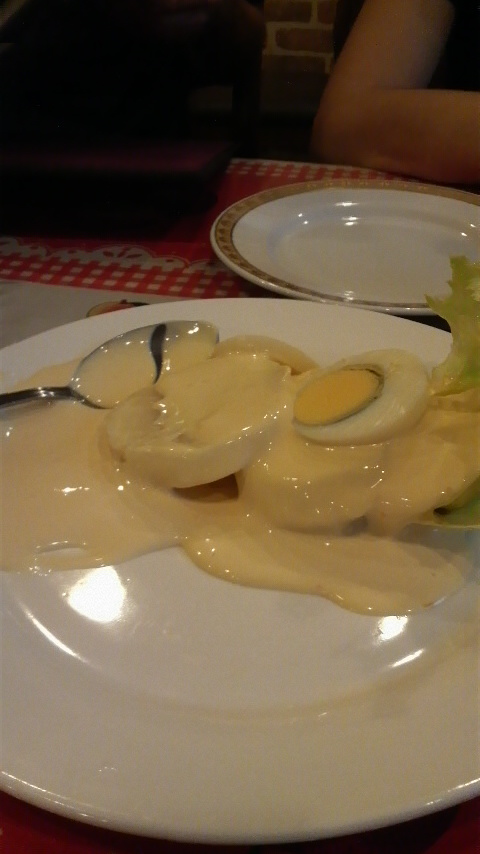 |
| Thick slices of potato topped with egg and a winning cream, at Arco Iris (Japan, 2009) |
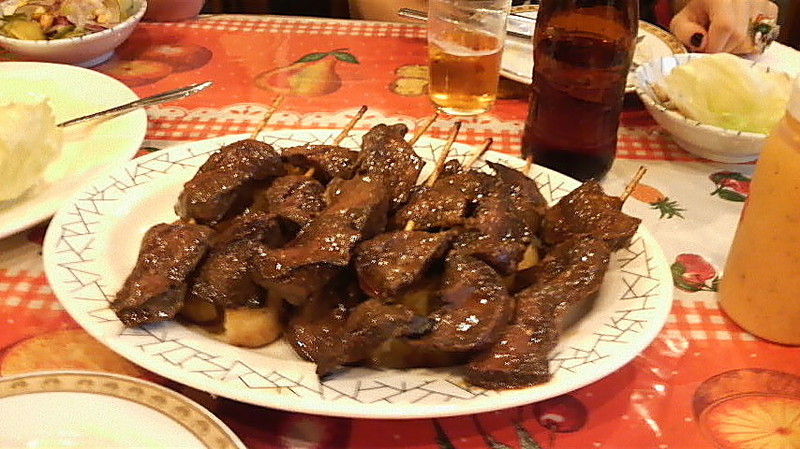 |
| Skewered cows' hearts, or so I was led to believe, laid atop a soft potato bed (Japan, 2009) |
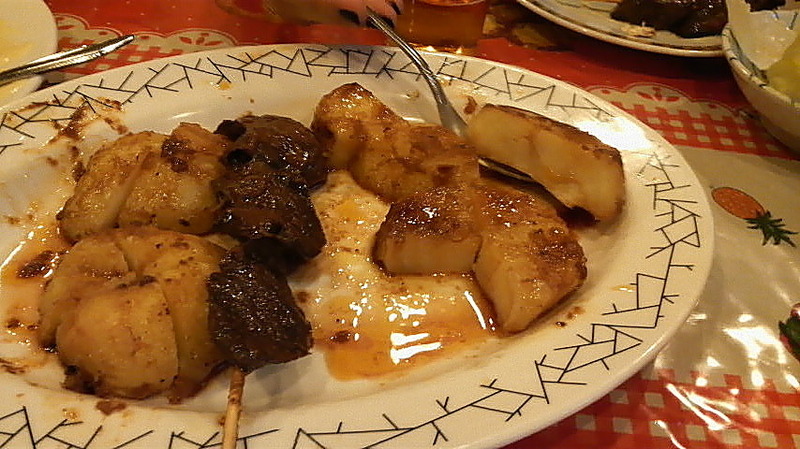 |
| The bed of beautiful potatoes lies exposed, beneath the skewered hearts (Japan, 2009) |
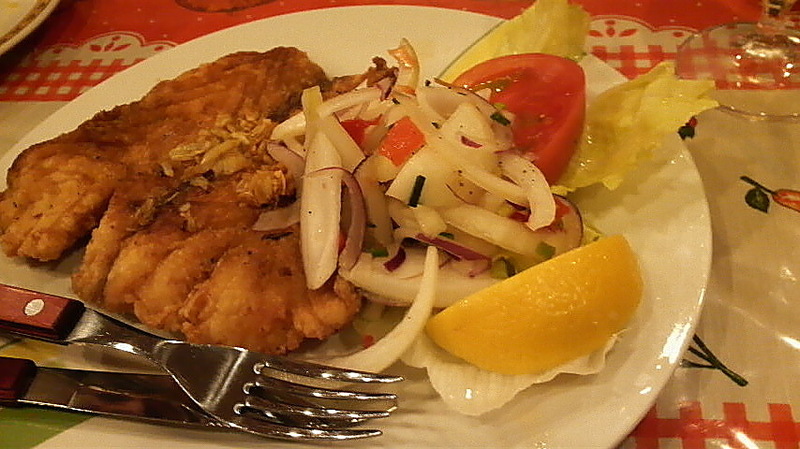 |
| Fish dish with salad, at the Arco Iris restaurant, near Gotanda station (Japan, 2009) |
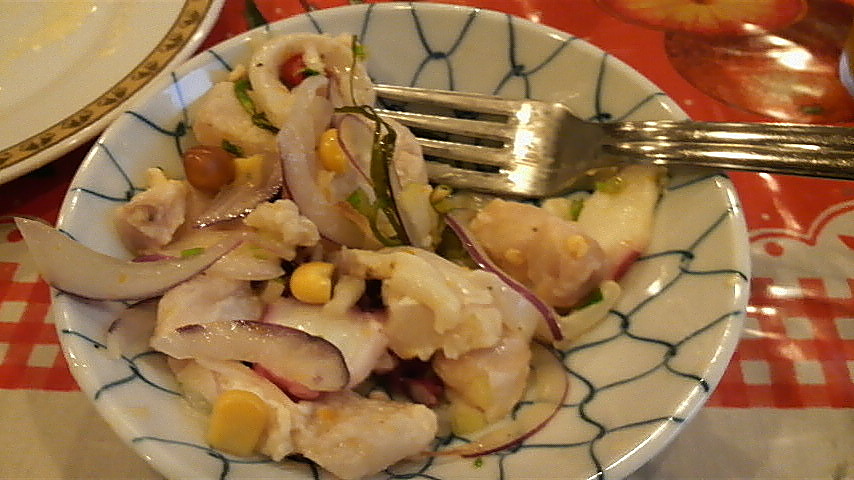 |
| This octopus salad ought to appeal to the Japanese palate (Japan, 2009) |
Monday, March 9, 2009
Cloudsurfing China, and Sailing Over Seoul
One crisp winter afternoon in January last year I was cruising the skies of north-east Asia as is sometimes my wont, on my way home from an outbreak of hot tropical love in Vietnam. I was nursing one monster hangover accrued from my antics at the Window's Cafe and Bar in Ho Chi Minh City nearly 24 hours earlier, a condition sorely compounded by those couple of extra beers I downed at Tân Sơn Nhất Airport waiting for my ride. I thought that if I just kept on drinking, I could drink the hangover away. Or at least keep it at bay, until I lost myself in sleep. But I hadn't factored in the infuriatingly stop-start nature of travelling in (or through) China, which makes sleep, or indeed any form of relaxation, exceedingly precarious. To give you an example, my bird (Air China) was leaving Ho Chi Minh at a ridiculous time -- 1.45am or something, but I suppose that's what you pay for when you always opt for the cheapest airliner! It was literally the last flight out, and I was the last guy drinking at the bar, downing Tigers with ice, as our Beijingbound Air China glided in. I watched it all behind the dirty panes in the brandnew airport concourse. Presently I shuffled on-board with all the blearyeyed zombies, quite a few Germans all speaking German, and took my superdownsized seat. I was in the mood for sleep. And who knows, I might have found it, if it were not the fact that this was a Chinese flight. An hour or so into the flight, just as I had probably begun to doze off, the plane shifted into descent mode, and the stewardesses came around, waking everyone up. I wasn't surprised, since I had encountered this anomaly a few weeks earlier, on my way to Vietnam. It is not listed on your ticket or travel itinerary, but when you fly from Beijing to Ho Chi Minh City you stop en-route at Nanning, capital of the Guangxi Zhuang Autonomous Region (广西壮族自治区). There to shuffle off the plane, get confused, and wait in line for needless visa checks and passport inspections. We spent more than an hour waiting for our transit visas, and this was at 4am or something, at the end of a long session of heavy drinking (for me at least). For some strange Chinese reason only one guy (or girl) was processing passports in passport control, even though there were five or six guys/girls sitting at their desks, resplendent in their official attire. This meagerness was not lost on the Germans in the line. "Eins, zwei, drei, vier, fünf," they said, counting them one by one, "fünf nicht arbeiten!" All of the just sitting there, in other words, doing nothing. What waste, the Germans were doubtless thinking... what Communist inefficiency! By this stage, 12 hours after I started drinking, I was feeling decidedly green, and in desperate need for some sleep. My passport was stamped, eventually. We were herded back aboard our plane as sunrise revealed a rather pleasant series of yellow apartment blocks near the airport, kids going off to school, and adults to work. Yellow was actually the color of the day, yellow and pale blue, yellow and sulphurous brown. Skysurfing southern China was a smudge of sulphuric smog, the ground barely visible, that vast agricultural heartland conspicuous in its absence. I took occasional peeks out of the window, between drifts into light sleep. Peaks of cloud drifted by. Everyone on the opposite side of the cabin gawked out the window as we approached Beijing, seeing something I couldn't see... maybe it was the Great Wall (but isn't that to the north?) At Beijing airport we spent more time waiting in futile lines. On the bright side, I didn't get as badly lost as I did on my first visit, that foggy carbon-heavy night just before Christmas, at the very start of my adventure. I boarded my plane to Tokyo, Japan, and we took off in pale sunshine -- the temperature was about 0 degrees C. We hit the clouds again, heading east. I think I did actually get some sleep, like an hour or so. But I was continually being distracted by the interesting scenes which opened up below, like a panorama: Dalian (大连) on its peninsula looking like a neat place to live, and finally, a little later, a dramatic metropolis emerging from the mountains, spread out like a circuit-board, or a subway map: Seoul (서울), capital of the Republic of Korea, and Jewel of the Yellow Sea.
If I recall correctly, there was a commercial airliner flying by at much the same altitude, but in the opposite direction to us. I looked down to see, much lower, a smaller craft possibly coming into land in the city. Something about the sight of these two planes flying at different altitudes, the sense of three dimensional perspective they engendered, had a magical effect on me. It was like discovering a whole world and an entire way of life miniaturized into one of those bauble things they used to sell which snow inside whenever you shake them. There was a civilization there compressed between the mountains, and as I looked ever more intently, I could make out landmarks I had encountered on my previous forays here, back in 2002 and 2003. The city was laid out like a circuit-board, like a subway map bereft of the subway stations (since they were underground), but nonetheless prominently hewn by the Han River, and peppered with yellow peaks. We were flying like 30,000 feet, but if I could have strapped on a parachute and bolted out the emergency door and tumbled down there, I would have done so in a heartbeat. Or probably not, that would have been foolish, and you need superhero strength to open those doors at cruising altitude. Anyway, you get my drift... it was sad to pass by without a night in a hof, drinking beer and chowing on the complementary peanuts. I had to fly on, back to dreary old Tokyo, where the wicked North Wind was waiting to knife me. But next month, if all goes to plan, I will be back in Seoul, this time on the ground. And if all goes to plan, plenty of fresh adventures await! Even a few fresh hofs, and all the peanuts I can eat. Thanks to the relative strength of the Japanese Yen, I think I will be able to down drinks for a third of the price that they cost in Tokyo. And that's always a bonus.
 |
| One of the many yellow hills of Seoul (South Korea, 2003) |
